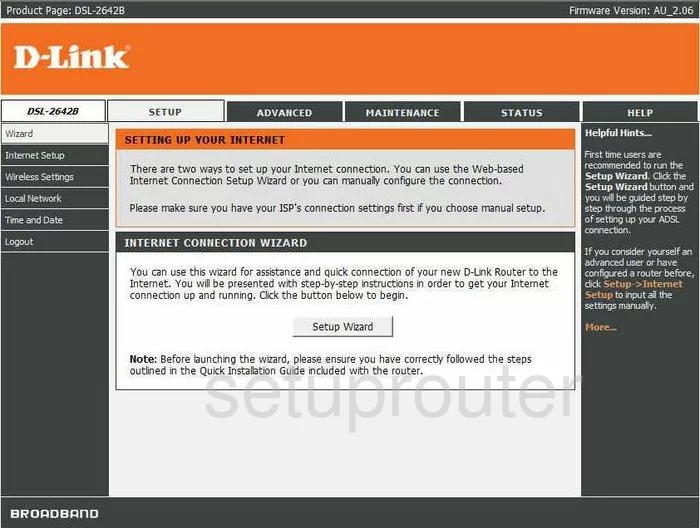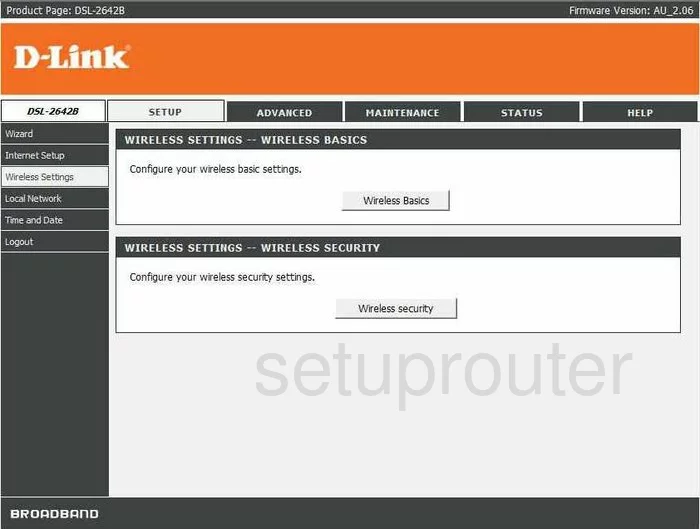The Dlink DSL-2642B router is considered a wireless router because it offers WiFi connectivity. WiFi, or simply wireless, allows you to connect various devices to your router, such as wireless printers, smart televisions, and WiFi enabled smartphones.
Other Dlink DSL-2642B Guides
This is the wifi guide for the Dlink DSL-2642B. We also have the following guides for the same router:
- Dlink DSL-2642B - How to change the IP Address on a Dlink DSL-2642B router
- Dlink DSL-2642B - Dlink DSL-2642B Login Instructions
- Dlink DSL-2642B - Dlink DSL-2642B User Manual
- Dlink DSL-2642B - Dlink DSL-2642B Port Forwarding Instructions
- Dlink DSL-2642B - How to change the DNS settings on a Dlink DSL-2642B router
- Dlink DSL-2642B - How to Reset the Dlink DSL-2642B
- Dlink DSL-2642B - Information About the Dlink DSL-2642B Router
- Dlink DSL-2642B - Dlink DSL-2642B Screenshots
WiFi Terms
Before we get started there is a little bit of background info that you should be familiar with.
Wireless Name
Your wireless network needs to have a name to uniquely identify it from other wireless networks. If you are not sure what this means we have a guide explaining what a wireless name is that you can read for more information.
Wireless Password
An important part of securing your wireless network is choosing a strong password.
Wireless Channel
Picking a WiFi channel is not always a simple task. Be sure to read about WiFi channels before making the choice.
Encryption
You should almost definitely pick WPA2 for your networks encryption. If you are unsure, be sure to read our WEP vs WPA guide first.
Login To The Dlink DSL-2642B
To get started configuring the Dlink DSL-2642B WiFi settings you need to login to your router. If you are already logged in you can skip this step.
To login to the Dlink DSL-2642B, follow our Dlink DSL-2642B Login Guide.
Find the WiFi Settings on the Dlink DSL-2642B
If you followed our login guide above then you should see this screen.

You begin on Setup Wizard page of the Dlink DSL-2642B router. To configure the WiFi settings, click the link on the left titled Wireless Settings.
Change the WiFi Settings on the Dlink DSL-2642B

- First, click the button titled Wireless Basics.
- Next, find the box labeled Wireless Network Name (SSID). Enter a name you want to be identified with here. This name is seen by other wireless devices so don't use personal information. To learn more about the SSID, read our guide on the topic by clicking this link.
- Now find the box that reads Wireless Channel. Here you need to make sure you are on a channel that is friendly to your neighbors. You should use channel 1,6, or 11. To learn why these channels are neighbor friendly, read our guide on the topic by clicking this link.
- Click the Apply button and you are finished with this page.
Click the Wireless Settings link in the left sidebar again to access the wireless submenu page. Click the option of Wireless security.
- The first section of this new page deals with WPS. This can be cracked very easily we recommend not using this connection option. Make sure that WPS is Disabled. To learn more about this topic, read our guide by clicking this link.
- The next section is called Wireless SSID. Use the drop down menu titled Select SSID to choose the wireless name you just created on the previous page.
- After that is the section called Manual Setup AP. We recommend setting the Network Authentication to WP-Personal/WPA2 only. To learn what this is and your other options, read our guide by clicking this link.
- Below that is the WPA Pre-Shared Key. This is the password you use to access the internet. This is also used in the encryption method so make sure to use a strong password of at least 14-20 characters. Use a mix of letters, numbers, and symbols. To learn how to create a strong and memorable password read our guide by clicking this link.
- You can leave the WPA Group Rekey Interval at the default value. This is how often the router creates a new key from your password. A typical setting is 3600 seconds.
- The last thing you may want to change is the WPA Encryption. We recommend using the stronger and newer AES.
- Tick the Apply button and you are finished.
Possible Problems when Changing your WiFi Settings
After making these changes to your router you will almost definitely have to reconnect any previously connected devices. This is usually done at the device itself and not at your computer.
Other Dlink DSL-2642B Info
Don't forget about our other Dlink DSL-2642B info that you might be interested in.
This is the wifi guide for the Dlink DSL-2642B. We also have the following guides for the same router:
- Dlink DSL-2642B - How to change the IP Address on a Dlink DSL-2642B router
- Dlink DSL-2642B - Dlink DSL-2642B Login Instructions
- Dlink DSL-2642B - Dlink DSL-2642B User Manual
- Dlink DSL-2642B - Dlink DSL-2642B Port Forwarding Instructions
- Dlink DSL-2642B - How to change the DNS settings on a Dlink DSL-2642B router
- Dlink DSL-2642B - How to Reset the Dlink DSL-2642B
- Dlink DSL-2642B - Information About the Dlink DSL-2642B Router
- Dlink DSL-2642B - Dlink DSL-2642B Screenshots